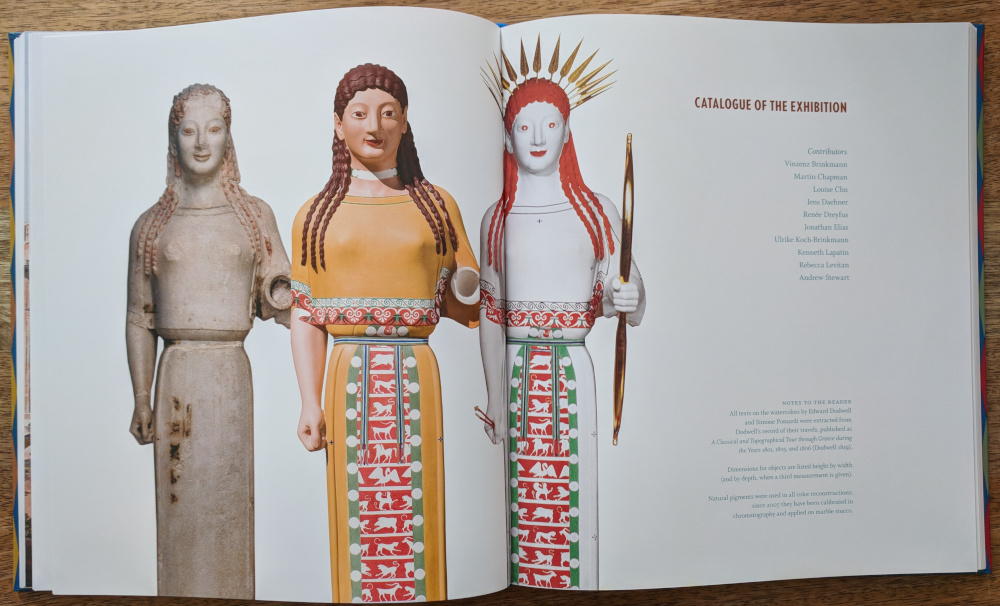Gods in Color
-
prestelpublishing.randomhouse.de/book/Gods-in-Color/Vinzenz-Brinkmann/Prestel-com/e529893.rhd#info
Online stores Amazon Review sites Goodreads -
gods-in-color-1541138364855.jpg
Reconstruction of the Peplos Kore as featured in the book.Credit: Gods in Color. Fair use.Source: own photographReviews
Please sign in or register to add your own review.
Scratching the surface of antiquityAncient statues and buildings were frequently painted in vivid colors. The modern image of austere white marble is largely an invention, based on misunderstanding the weathered appearance of ancient works as intentional. That invention became the preferred view of antiquity from the Renaissance to today.
Ancient polychromy is not, however, a recent discovery. After all, statues often still had pigments on them when they were discovered (many still do so today). Historians like Johann Winckelmann (1717-1768) acknowledged that many ancient statues were colored, but claimed that “the whiter the body is, the more beautiful it is.”
The true colors of the ancient world reflect the diversity of the people that inhabited it. They also make the ancient West look a lot more like the ancient East, offering a glimpse at the thread that connects all humanity; sharpening the contrast between the polytheistic, messy culture of ancient Rome and the darkening age that followed it.
Since Winckelmann, historians have rarely embraced, sometimes rejected and mostly ignored the true colors of antiquity. In recent decades, a small number of archaeologists and historians have tried to change that, culminating in an exhibition of painted statues called Gods in Color which first opened 2003 and has been continuously updated since then. The book Gods in Color: Polychromy in the Ancient World is a catalog of the exhibition with some additional essays on the subject.

Reconstruction of the Peplos Kore as featured in the book. (Credit: Gods in Color. Fair use.)The introductory essays are short but interesting, shedding light on the discovery and perception of ancient polychromy, and giving examples of early drawings and reconstructions.
The new reconstructions, however, may offend modern sensibilities. This is less because they’re colorful and more because they just are not very well done. As Margaret Talbot writes in the excellent New Yorker article “The Myth of Whiteness in Classical Sculpture”:
In the nineteen-nineties, [Vincent] Brinkmann and his wife, Ulrike Koch-Brinkmann, who is an art historian and an archeologist, began re-creating Greek and Roman sculptures in plaster, painted with an approximation of their original colors. Palettes were determined by identifying specks of remaining pigment, and by studying “shadows”—minute surface variations that betray the type of paint applied to the stone. The result of this effort was a touring exhibition called “Gods in Color”.
(…)
But [Mark] Abbe, like many scholars I talked to, wasn’t crazy about the reconstructions in “Gods in Color.” He found the hues too flat and opaque, and noted that plaster, which most of the replicas are made from, absorbs paint in a way that marble does not. He was also bothered by the fact that the statues “all look fundamentally the same, whereas styles would have differed enormously.”
All of this is true. Moreover, many of the depicted reconstructions are incomplete, with partially colored eyes or limbs creating a truly garish appearance. Where the original is damaged, so is the replica, with a white broken nose at the center of a flatly painted plaster reconstruction.
The pigments recovered from each original are carefully documented, but the artistic execution of most of the reconstructions is accordingly mechanistic, constrained by evidence that remains between us and the ancient world.
The result is a presentation of antiquity in painted plaster that resembles the uncanny valley of bad computer graphics. The Brinkmanns and their collaborators deserve the world’s credit for forcing us to take a more realistic view of the ancient world in its full color—but a lot of work remains to do so in style.
